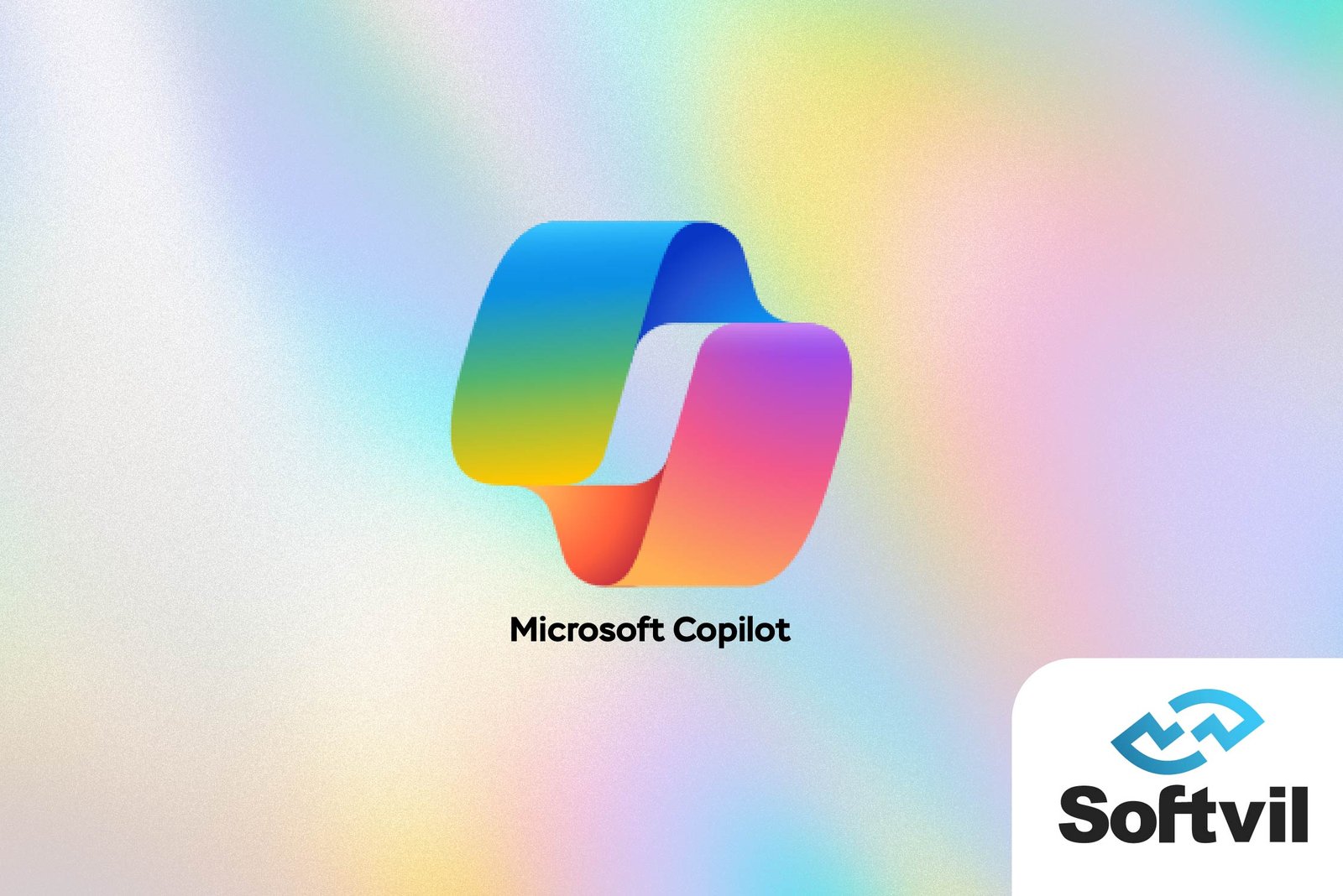- Introduction
- What Is Microsoft Copilot?
- Integration Across Word, Excel, PowerPoint, Teams, and Outlook
- How Copilot Works: Microsoft Graph and Large Language Models
- Licensing Basics: Getting Started with Microsoft Copilot 365
- Security and Data Privacy Considerations
- Quick Wins for Different Business Sizes
- Steps to a Successful Implementation
- The Strategic Value of Microsoft Copilot
- Looking Ahead
- Final Thoughts
- FAQs
- About Softvil
Introduction
Artificial intelligence is no longer a futuristic concept for enterprises—it’s a practical tool shaping day-to-day work. Microsoft Copilot stands at the forefront of this transformation, integrating generative AI directly into the Microsoft 365 ecosystem. For business decision-makers considering adoption, understanding its core capabilities, security framework, and practical benefits is essential. This guide explores everything leaders need to know before implementing Microsoft Copilot 365, from its technical foundations to licensing and quick wins for businesses of any size.
What Is Microsoft Copilot?

Microsoft Copilot is an AI-powered assistant that embeds cutting-edge generative AI into the familiar suite of Microsoft productivity tools—Word, Excel, PowerPoint, Outlook, and Teams. Unlike standalone AI applications, Copilot for Microsoft 365 operates within the platforms employees already use, streamlining tasks and enhancing productivity without disrupting established workflows.
At its heart, Microsoft Copilot uses natural language processing to help users generate content, summarize information, analyze data, and automate repetitive tasks. Whether drafting a proposal in Word, creating dynamic presentations in PowerPoint, uncovering trends in Excel, or summarizing meeting notes in Teams, Microsoft Copilot features are designed to save time and boost creativity.
Integration Across Word, Excel, PowerPoint, Teams, and Outlook

One of the strongest Microsoft Copilot benefits is its seamless integration across core Microsoft 365 applications.
Word
With Microsoft Copilot, users can generate first drafts, rewrite sections, and refine tone or style with simple prompts. It can summarize lengthy reports or help convert meeting notes into professional documents in minutes.
Excel
In Excel, Microsoft Copilot features allow users to analyze complex datasets using plain language queries. Instead of manually writing formulas, decision-makers can simply ask Copilot to “highlight the top-performing regions this quarter” or “forecast next month’s revenue.”
PowerPoint
Creating engaging presentations becomes effortless. Microsoft Copilot can transform a Word document or a set of notes into a polished slide deck, complete with suggested layouts, imagery, and speaker notes.
Teams
Meeting productivity improves through real-time transcription, automatic summarization, and intelligent action-item tracking. Teams integrated with Copilot for Microsoft 365 can quickly distribute meeting recaps, reducing the burden of manual documentation.
Outlook
Inbox overload is easier to manage with Microsoft Copilot 365. It drafts responses, organizes email threads, and highlights urgent tasks, ensuring important communications are never missed.
By embedding AI directly into these familiar tools, Microsoft Copilot benefits become accessible to users with minimal training, delivering immediate value.
How Copilot Works: Microsoft Graph and Large Language Models

Behind the user-friendly interface, Microsoft Copilot features a sophisticated technical architecture. It combines the power of large language models (LLMs), such as OpenAI’s GPT, with the rich data and context provided by Microsoft Graph.
- Microsoft Graph acts as a secure connector, mapping the relationships between users, emails, documents, meetings, and chats within an organization’s Microsoft 365 environment.
- Large language models process natural language prompts, generate human-like responses, and perform advanced reasoning tasks.
This dual approach means Copilot for Microsoft 365 doesn’t just generate generic answers. Instead, it tailors outputs based on the user’s context—referencing relevant emails, files, and calendar events—while respecting permissions and access controls.
Licensing Basics: Getting Started with Microsoft Copilot 365

For organizations eager to adopt Microsoft Copilot 365, understanding licensing is critical.
- Add-On Model: Microsoft Copilot is offered as an add-on to existing Microsoft 365 or Office 365 subscriptions. Businesses must maintain a compatible plan such as Microsoft 365 E3 or E5.
- Per-User Pricing: Licensing typically follows a per-user, per-month fee. Decision-makers should evaluate anticipated adoption rates and role-specific needs to estimate costs accurately.
- Pilot Programs: Before a full rollout, many companies start with a pilot group. This approach allows IT teams to test functionality, collect feedback, and calculate ROI.
Budgeting for Microsoft Copilot 365 requires considering not just subscription fees but also potential training sessions and any integration with custom workflows.
Security and Data Privacy Considerations

For most businesses, data privacy is a top priority. Fortunately, Microsoft Copilot inherits Microsoft 365’s enterprise-grade security framework.
- Data Residency and Compliance
Copilot for Microsoft 365 respects existing compliance commitments, including GDPR and industry-specific standards such as HIPAA. Data remains within the organization’s Microsoft 365 tenant. - Role-Based Access
Microsoft Copilot features adhere to the same access permissions set within Microsoft 365. If an employee cannot access a document manually, Copilot cannot surface it in responses. - No Training on Your Data
A common concern is whether Microsoft Copilot 365 trains its models using proprietary business data. Microsoft assures users that organizational data is not used to train the underlying LLM. - Audit and Logging
Administrators can review usage logs and implement conditional access policies to maintain oversight and address potential security incidents.
By leveraging existing Microsoft 365 security infrastructure, Microsoft Copilot benefits businesses that need AI assistance without sacrificing data integrity.
Quick Wins for Different Business Sizes

The versatility of Microsoft Copilot 365 makes it attractive to businesses of all scales. Here’s how organizations of varying sizes can realize immediate value:
Small Businesses
Small teams often juggle multiple roles. Microsoft Copilot features like automated email drafting and simplified report generation free up time for customer engagement and strategic growth. Even with a limited IT team, small businesses can deploy Copilot for Microsoft 365 to boost productivity with minimal setup.
Mid-Sized Companies
For medium enterprises, Microsoft Copilot benefits include streamlining cross-department collaboration. Teams can use AI to quickly create unified reports, summarize multi-meeting projects, and identify patterns in sales data without hiring additional analysts.
Large Enterprises
Enterprises with complex workflows can leverage Microsoft Copilot 365 for advanced analytics, enterprise-wide communication, and automated content creation at scale. Integration with Microsoft Graph ensures AI-generated insights are grounded in the organization’s unique data ecosystem.
Steps to a Successful Implementation

Adopting Microsoft Copilot is more than flipping a switch. Decision-makers should follow a structured plan:
- Assess Business Goals
Identify specific challenges—such as slow reporting or communication overload—that Microsoft Copilot features can address. - Engage Stakeholders Early
Include IT, security teams, and department leaders to ensure alignment and to anticipate potential roadblocks. - Pilot and Train
Roll out Copilot for Microsoft 365 to a limited group, collect feedback, and provide hands-on training. Encourage employees to experiment with prompts to unlock the full range of Microsoft Copilot benefits. - Measure ROI
Track key metrics like time saved, output quality, and employee satisfaction. Use these insights to guide a broader rollout.
The Strategic Value of Microsoft Copilot

The arrival of Microsoft Copilot 365 signals a new era of workplace productivity. By embedding AI into daily workflows, organizations can reduce manual tasks, accelerate decision-making, and empower employees to focus on high-value activities.
Key strategic advantages include:
- Productivity Gains: Automating routine tasks frees employees for strategic work.
- Enhanced Creativity: Microsoft Copilot features help teams brainstorm and create high-impact content quickly.
- Data-Driven Insights: With Microsoft Graph integration, AI suggestions are based on real organizational data, not generic internet sources.
- Scalability: Whether for a five-person startup or a multinational corporation, Microsoft Copilot benefits can scale with business growth.
Looking Ahead
The rapid adoption of Microsoft Copilot 365 underscores a broader trend: AI is becoming a standard business tool, not a niche experiment. As Microsoft continues to refine its models and add capabilities, decision-makers who embrace Copilot for Microsoft 365 early will gain a competitive edge.
Businesses that plan carefully—evaluating licensing, ensuring data privacy, and identifying quick wins—can unlock the full potential of Microsoft Copilot. From drafting reports in Word to analyzing enterprise data in Excel, the possibilities are vast.
Final Thoughts
For decision-makers evaluating AI solutions, Microsoft Copilot offers a powerful, secure, and scalable path to intelligent productivity. By leveraging Microsoft Graph and advanced language models, Microsoft Copilot 365 provides actionable insights and seamless automation within the tools employees already know. With careful planning and a focus on strategic deployment, organizations can reap substantial Microsoft Copilot benefits, driving efficiency and innovation well into the future.
FAQs
Microsoft Copilot is an AI assistant built into Microsoft 365 apps like Word, Excel, PowerPoint, Teams, and Outlook to help users draft, analyze, and automate tasks using natural language prompts.
Microsoft Copilot 365 accesses your data through Microsoft Graph to provide context-aware answers but does not use your data to train its AI models and respects all existing Microsoft 365 permissions.
You need an eligible Microsoft 365 subscription (such as E3 or E5) and a separate add-on license to enable Copilot for Microsoft 365 for each user.
Yes. Microsoft Copilot features inherit Microsoft 365’s enterprise-grade security, including encryption, compliance certifications, and role-based access controls.
Key Microsoft Copilot benefits include faster content creation, simplified data analysis, and reduced email overload—helping small teams save time and focus on growth.
About Softvil
Softvil is a forward-thinking software development company specializing in custom solutions, IT consulting, and managed services. With expertise spanning web and mobile applications, cloud integration, and cutting-edge technologies, Softvil helps businesses of all sizes streamline operations and drive digital transformation. By combining agile methodologies with a customer-first approach, Softvil delivers scalable, high-quality software that empowers organizations to innovate and stay competitive in a fast-changing market.

